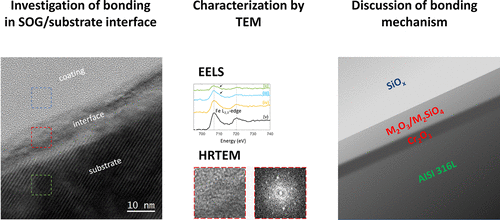Our official English website, www.x-mol.net, welcomes your
feedback! (Note: you will need to create a separate account there.)
Probing the Chemistry of Adhesion between a 316L Substrate and Spin-on-Glass Coating
Langmuir ( IF 3.7 ) Pub Date : 2018-02-19 00:00:00 , DOI: 10.1021/acs.langmuir.7b03131 Felix Lampert 1 , Shima Kadkhodazadeh 2 , Takeshi Kasama 2 , Kristian Vinter Dahl 1 , Alexander Bruun Christiansen 3 , Per Møller 1
Langmuir ( IF 3.7 ) Pub Date : 2018-02-19 00:00:00 , DOI: 10.1021/acs.langmuir.7b03131 Felix Lampert 1 , Shima Kadkhodazadeh 2 , Takeshi Kasama 2 , Kristian Vinter Dahl 1 , Alexander Bruun Christiansen 3 , Per Møller 1
Affiliation

|
Hydrogen silsesquioxane ([HSiO3/2]n)-based “spin-on-glass” has been deposited on a 316L substrate and cured in Ar/H2 gas atmosphere at 600 °C to form a continuous surface coating with submicrometer thickness. The coating functionality depends primarily on the adhesion to the substrate, which is largely affected by the chemical interaction at the interface between the coating and the substrate. We have investigated this interface by transmission electron microscopy and electron energy loss spectroscopy. The analysis identified a 5–10 nm thick interaction zone containing signals from O, Si, Cr, and Fe. Analysis of the energy loss near edge structure of the present elements identified predominantly signal from [SiO4]4– units together with Fe2+, Cr2+, and traces of Cr3+. High-resolution transmission electron microscopy images of the interface region confirm a crystalline Fe2SiO4 interfacial region. In agreement with computational thermodynamics, it is proposed that the spin-on-glass forms a chemically bonded silicate-rich interaction zone with the substrate. It was further suggested that this zone is composed of a corundum-type oxide at the substrate surface, followed by an olivine-structure intermediate phase and a spinel-type oxide in the outer regions of the interfacial zone.
中文翻译:

探索316L基材与旋涂玻璃涂层之间的粘附化学
基于氢倍半硅氧烷([HSiO 3/2 ] n)的“旋涂玻璃”已沉积在316L基板上,并在Ar / H 2气体气氛中于600°C固化,以形成亚微米厚度的连续表面涂层。涂层的功能性主要取决于对基材的粘附力,而粘附力很大程度上受涂层和基材之间的界面处的化学相互作用的影响。我们已经通过透射电子显微镜和电子能量损失谱研究了该界面。分析确定了一个5-10 nm厚的相互作用区域,其中包含来自O,Si,Cr和Fe的信号。分析目前元素的边缘结构附近的能量损失,主要是从[SiO 4 ] 4–单元与Fe 2 +,Cr 2+和痕量Cr 3+一起。界面区域的高分辨率透射电子显微镜图像确认了结晶的Fe 2 SiO 4界面区域。与计算热力学一致,提出旋涂玻璃与基底形成化学键合的富含硅酸盐的相互作用区域。进一步表明,该区域由在基底表面的刚玉型氧化物组成,随后在界面区域的外部区域由橄榄石结构中间相和尖晶石型氧化物组成。
更新日期:2018-02-19
中文翻译:

探索316L基材与旋涂玻璃涂层之间的粘附化学
基于氢倍半硅氧烷([HSiO 3/2 ] n)的“旋涂玻璃”已沉积在316L基板上,并在Ar / H 2气体气氛中于600°C固化,以形成亚微米厚度的连续表面涂层。涂层的功能性主要取决于对基材的粘附力,而粘附力很大程度上受涂层和基材之间的界面处的化学相互作用的影响。我们已经通过透射电子显微镜和电子能量损失谱研究了该界面。分析确定了一个5-10 nm厚的相互作用区域,其中包含来自O,Si,Cr和Fe的信号。分析目前元素的边缘结构附近的能量损失,主要是从[SiO 4 ] 4–单元与Fe 2 +,Cr 2+和痕量Cr 3+一起。界面区域的高分辨率透射电子显微镜图像确认了结晶的Fe 2 SiO 4界面区域。与计算热力学一致,提出旋涂玻璃与基底形成化学键合的富含硅酸盐的相互作用区域。进一步表明,该区域由在基底表面的刚玉型氧化物组成,随后在界面区域的外部区域由橄榄石结构中间相和尖晶石型氧化物组成。











































 京公网安备 11010802027423号
京公网安备 11010802027423号